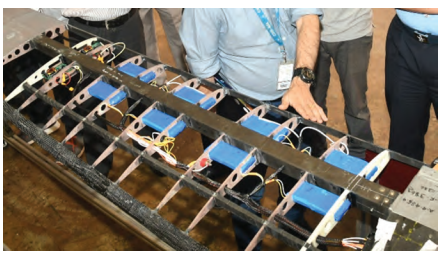SOURCE: RAUNAK KUNDE / NEWS BEAT / IDRW.ORG

The National Aerospace Laboratories (NAL) has recently released its annual report, shedding light on the significant advancements made in the development of High-Altitude Pseudo-Satellite (HAP) technology. The report showcases the meticulous design and analysis, testing, and integration processes carried out in the creation of the HAP Sub-Scale (HAP SS), which represents a groundbreaking advancement in aeronautical engineering.
Here are the key highlights from NAL’s annual report:

HAP Sub-Scale (HAP SS) Development:
The development journey begins with the creation of a 1:3 subscale HAP, referred to as the HAP Sub-Scale or ‘HAP SS.’ This sub-scale model is designed for lower altitude flight with shorter endurance, serving as a crucial stepping stone in the development of larger-scale HAP technology.
Wing and Tail Design:
The report details the design and analysis of the HAP SS wing with aileron and Horizontal Tail (HT) with elevator. Comprehensive construction details, material selection, and weight targets were meticulously assessed to ensure optimal performance.
Electrical System Development:
An electrical system with lower performance was selected based on inputs from various technical groups, including aerodynamics, propulsion, energy management, and avionics. Studies involving different types of batteries and avionics were carried out to refine the electrical system’s architecture.
Aeroelastic Analysis:
Static, dynamic, and aeroelastic studies were conducted on the fully integrated Finite Element (FE) model of HAP SS. These studies included critical load cases, discrete gust response analysis, and fluid-structure interaction analysis. The latter utilized a high-fidelity coupled Computational Structural Dynamics (CSD) and Computational Fluid Dynamics (CFD) approach to assess the vehicle’s aeroelastic behaviour.
Power System and Control Laws:
Battery pack placement, PV array layout, and power system wire sizing were finalized during the reporting period. The Power Distribution and Regulation (EMPS) system Preliminary Design Review (PDR) was completed. Additionally, the Ground Power Control Unit (GPCU) was developed in-house to charge batteries and perform system-related acceptance tests.
Flight Model and Control Laws:
A comprehensive flight model and control laws were developed. The report discusses the 6 Degrees of Freedom (6 DoF) model, which was created based on the aerodynamic database generated through Computational Fluid Dynamics (CFD). Additionally, control laws and feedback control structures were designed and tested through software-in-loop simulation studies.
Launch Strategies and Location Selection:
The report also delves into launch strategies, launch location selection, and the estimation of available solar power. Preliminary analysis was carried out for surface wind and solar irradiance at the candidate launch location in Chitradurga.
NOTE : Article cannot be reproduced without written permission of idrw.org in any form even for YouTube Videos to avoid Copy right strikes. Websites doing illegal reproductions will get DCMA and Legal Notices.